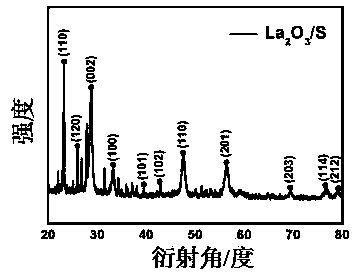A method for preparing a sulfur-based cathode material by using reticulated porous nano-lanthanum oxide
A technology of nano-lanthanum oxide and positive electrode materials, applied in battery electrodes, electrical components, circuits, etc., can solve problems such as low electron and ion transmission efficiency, shortened cycle life of lithium-sulfur batteries, and damage to the physical structure of electrodes, achieving spray drying and Easy hydrothermal strategy, excellent cycle stability, effect of shortening the transmission path
- Summary
- Abstract
- Description
- Claims
- Application Information
AI Technical Summary
Problems solved by technology
Method used
Image
Examples
Embodiment 1
[0025] The first step, the preparation of porous network nano-lanthanum oxide:
[0026] Mix 0.1 mol / L lanthanum nitrate and 0.9 mol / L urea at a volume ratio of 1:1, and then ultrasonically disperse the mixed solution for 3 h at 500 power using an ultrasonic cell pulverizer. The obtained homogeneous mixed solution was spray-dried. During spray drying, the temperature was kept at 400° C., the air flow rate was kept at 8 cc / min, the feed rate was 0.5 ml / min, and the needle passing rate was 1 time / 5 seconds. Since lanthanum nitrate and urea react chemically at 400°C to generate lanthanum oxide, nitrogen, carbon dioxide and water vapor, pure porous network nano-lanthanum oxide will be obtained after spray drying.
[0027] The second step, the preparation of porous network nano-lanthanum oxide / sulfur cathode material:
[0028] Weigh the required lanthanum oxide and nano-sulfur according to the mass ratio of 1:2, place the mixture in a mortar and grind it into a uniform fine powder...
Embodiment 2
[0033] The first step, the preparation of porous network nano-lanthanum oxide:
[0034] Mix 0.1 mol / L lanthanum nitrate and 0.9 mol / L urea at a volume ratio of 1:1, and then ultrasonically disperse the mixed solution at 600 power for 4 hours using an ultrasonic cell pulverizer. The obtained homogeneous mixed solution was spray-dried. During spray drying, the temperature was kept at 400° C., the air flow rate was kept at 10 cc / min, the feed rate was 1 ml / min, and the needle passing rate was 1 time / 8 seconds. Since lanthanum nitrate and urea react chemically at 400°C to generate lanthanum oxide, nitrogen, carbon dioxide and water vapor, pure porous network nano-lanthanum oxide will be obtained after spray drying.
[0035] The second step, the preparation of porous network nano-lanthanum oxide / sulfur cathode material:
[0036]Weigh the required lanthanum oxide and nano-sulfur according to the mass ratio of 1:4, place the mixture in a mortar and grind it into a uniform fine powd...
PUM
 Login to View More
Login to View More Abstract
Description
Claims
Application Information
 Login to View More
Login to View More - R&D
- Intellectual Property
- Life Sciences
- Materials
- Tech Scout
- Unparalleled Data Quality
- Higher Quality Content
- 60% Fewer Hallucinations
Browse by: Latest US Patents, China's latest patents, Technical Efficacy Thesaurus, Application Domain, Technology Topic, Popular Technical Reports.
© 2025 PatSnap. All rights reserved.Legal|Privacy policy|Modern Slavery Act Transparency Statement|Sitemap|About US| Contact US: help@patsnap.com



